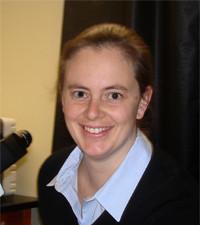Event
Special Physical Chemistry Seminar: Dr. Renne Frontiera
Title" Ultrafast Raman Spectroscopic Probes of Chemical Reaction Mechanisms"

Dr. Renee Frontiera
University of Minnesota
" Ultrafast Raman Spectroscopic Probes of Chemical Reaction Mechanisms"
- Ultrafast Raman spectroscopy is a powerful technique for monitoring chemical reaction dynamics in a range of complex environments, due to its ability to acquire structural snapshots of evolving molecular species on the femtosecond and picosecond timescale of chemical change. Our group develops and uses a range of Raman spectroscopies with high temporal and spatial resolution to monitor light-driven chemical reactions. This talk will focus on two applications which highlight the utility of ultrafast Raman spectroscopy. First, I will discuss the use of femtosecond stimulated Raman spectroscopy to design and screen new molecules for singlet fission. Singlet fission is a process in which an absorbed photon can be converted to two excited states, with great potential for increased photovoltaic efficiency. However, to date most molecules which undergo singlet fission are not suitable for long-term use. We show how ultrafast Raman measurements can identify molecular coordinates driving the singlet fission process, insights which we then use to design new molecules with improved performance. Secondly, I’ll discuss how ultrafast Raman measurements can determine reaction mechanisms relevant to plasmon-driven catalysis. Plasmonic nanomaterials are exciting photocatalysts due to their strong and tunable optical cross sections. However, the efficiencies of many plasmon-driven reactions are currently quite low, due to a lack of understanding of the underlying mechanisms. Here I’ll discuss how we use ultrafast Raman spectroscopy to quantify electron transfer reactions from plasmonic nanomaterials to molecules, and show how this fundamental understanding can be used to design photoinduced C-C bond forming reactions. Overall, these two stories demonstrate how ultrafast Raman spectroscopy can be used to inform rational molecular design
http://frontiera.chem.umn.edu
ZOOM Recording link
Copy the link below to share this recording with viewers:
https://upenn.zoom.us/rec/share/XaHXnULCJ_dOKbixOZI1eUhGlJilBb0A1MR4_TDvN41Gmih0Th4s7czaSmyz7pke.YMGw9O56A4bIOnpC
Passcode: !@298smB
